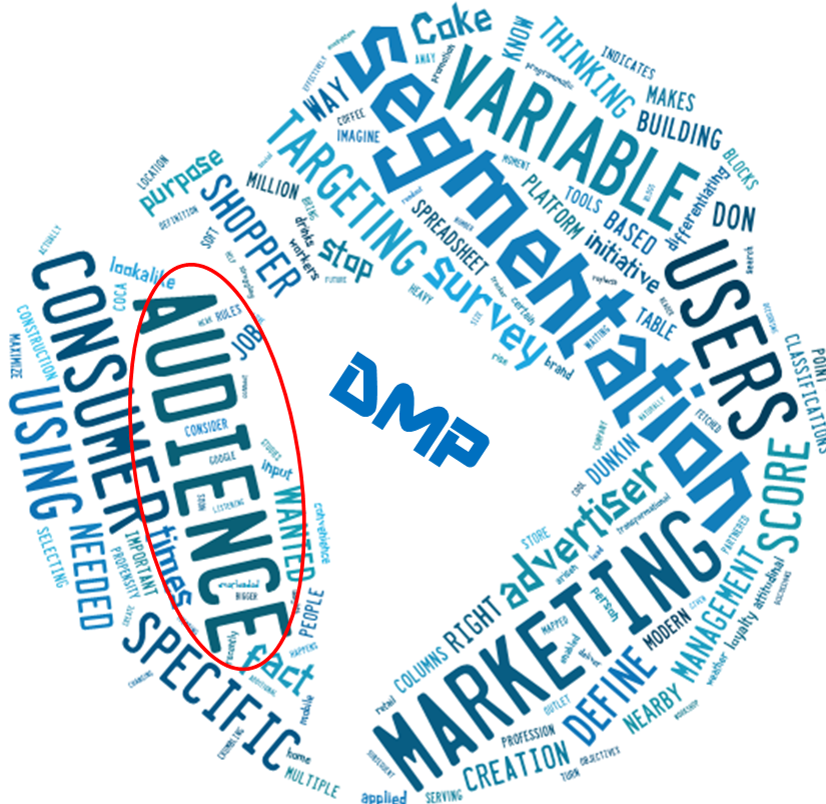Here is how marketers can create media strategies that provide BOTH better short term lift and long term brand-building value.
value.
First, Marketers, you have to stop only thinking of audiences the old way. Traditionally, it was the media company’s responsibility to attract an audience and you, the advertiser only had to decide if you wanted to buy it or not. Increasingly, in a digital age, it is THE ADVERTISER’S responsibility to define and enumerate audiences.
When marketing leaders talk about data driven marketing, the essence is this new way of thinking about audiences. They are enumerated by YOU, the marketer. You take the 100-200 million users in your DMP (Data management Platform) and you extract sub-sets that are suited to a given campaign element. You target these users programmatically wherever they decide to show up online. The organizing principle is no longer the TV show, magazine, or website…it is the user and the moment. Audiences arise by the marketer enumerating them, or by consumers engaging in a triggering action…like searching for something relevant to what you sell or showing up near a location where you sell something…and then you acting by serving ad impressions in those exact situations.
Audience creation is inherently about performance. You are enumerating the audience based on profiling variables that you believe will produce differentially higher response. Payoff: understanding this new way of thinking about audiences should lead to improving marketing productivity, the contribution that marketers get paid for.
Audiences and segments often sound like the same animal but they are not. For one thing, audience membership is temporary. The attractiveness of a user comes and goes. My car comes off lease in 9 months and I guarantee I will become VERY interesting to auto makers not too long from now. So there must be a contextual element to audience creation which the digital advertising ecosystem is very equipped to provide.
So to summarize, audience membership is about higher probability of response, precision targeting, ephemeral rather than lifetime membership, and a responsibility of the advertiser to use all their data assets to enumerate.
So if you, the advertiser, is now taking the lead at defining audiences, you need to rethink consumer segmentation to help you create the best audiences possible.
While audience creation is inherently about action, consumer segmentation is inherently about strategy.
Consumer segmentation drives the match between what you offer and what certain consumers want for a given need state. The real win will come by making these analytic methods of parsing consumers talk to each other.
In my most shared blog ever (over 3,200 shares), I talk about the 4 types of consumer segmentation in a digital and social age. In the traditional research view, you would pick one, and create maybe 5-7 segments. You might subsequently create another segmentation, say a shopper segmentation and then wonder when to use one vs. the other. In data driven marketing, you should do all four kinds of segmentation (consumer lifestyles and needs, context, shopper, brand loyalty). In the past that would seem chaotic…now it is exactly the right path by making these segments building blocks for audiences.
Hypothetically, imagine if Pepsi wanted to target construction workers with the idea of a Pepsi after the job. No single dimension segmentation could ever maximize response to this initiative. You need an audience, comprised of multiple segment types as well as other profiling variables! The audience might be defined by the intersection of:
- An attitudinal consumer segment
- A shopper segmentation profiling variable that indicates this person occasionally buys soft drinks from a convenience store or QSR.
- A “profession” variable in the DMP
- A brand propensity score (e.g. IRI proscore) so we know which users consider buying Pepsi.
- Ad serving and bidding rules that are based on weather, location so if you know this user is away from home at a certain time on a hot day, you can heavy-up spending on mobile for that moment-based marketing.
To pull this off, the media agency, consumer research team, and marketing must work very closely together to develop a precision targeting playbook. This mostly does not happen today, but it could.
Design your consumer segments to be the building blocks for advertiser defined audiences. In this way, you have a targeting engine that is both strategic and tactical, producing superior short term lift in a way that is also on strategy.

